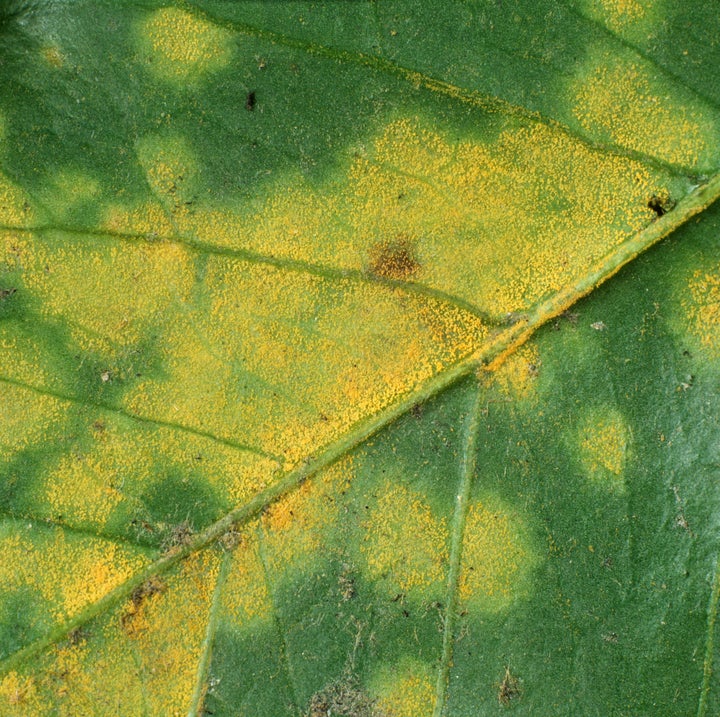
The British have long favored tea as their caffeinated beverage of choice, but another drink had its moment during the glory days of the British empire -- coffee.
In the 18th and 19th centuries, the British controlled vast coffee plantations across southern India and Ceylon, now known as Sri Lanka. But a strange fungal disease called coffee rust became widespread by the mid-19th century, crippling the industry and forcing producers to switch to tea cultivation. The change effectively altered beverage preferences across the empire as coffee drinkers were forced to switch as well, according to The Nature of Disease in Plants. Today, the region that was Ceylon is best known for the teas grown there.
Now the shift could be happening again in the "New World," as coffee rust strikes at crops across Central and South America. A recent outbreak is causing the worst devastation since the disease was first spotted in the Western Hemisphere in 1970; Guatemala has declared a national emergency, 2013-2014 harvests in some parts of Costa Rica may be half of what they were last year and there are troubling reports of the disease in Nicaragua, El Salvador and Mexico.
The pestilence is especially concerning when you consider that a significant chunk of the coffee consumed in the U.S. and abroad derives from beans grown in Central and South America. Data from the U.S. Department Of Agriculture puts Brazil, Colombia, Honduras, Peru, Guatemala and Mexico as some of the top 10 coffee producing countries in the world.
But coffee culture in the Americas may not be doomed. Leading the charge is Colombia's Cenicafé, a research organization funded by the Federación Nacional de Cafeteros de Colombia (National Federation of Coffee Growers of Colombia). The federation represents the interests of more than 500,000 producers, the vast majority of them small farms.
"[Y]ou can actually take care of the rust and control it," Cenicafé's Alvaro Gaitan said in an interview with The Huffington Post. Gaitan is the research center's head of plant pathology. But, he cautioned, "with coffee rust, you can not wait until the water is around your neck. You have to work really fast."
Thanks to early research, Cenicafé was ready with a rust-resistant coffee plant variety a year before the pestilence first struck Colombian operations in 1983, according to Gaitan. The so-called "Colombian" variety is a cross between the Caturra variety, which thrives in Colombian climates, and Southeast Asia's Timor hybrid, which was discovered to be coffee-rust-resistant in the 1960s by the Food and Agriculture Organization of the United Nations. A second generation of the variety, called Castillo, was released in 2005.
Cenicafé's foresight has been helpful during this most recent coffee rust outbreak, especially since Colombia was initially hit harder than other nations, Gaitan said. This is partly due to the ocean-atmosphere phenomenon La Niña, which brought heavy rains to parts of the region. Between 2008 and 2011, the increased rainfall provided an ideal environment for the fungus in some areas, and in August of 2011, Colombian coffee exports fell to their lowest level since 1988 following a particularly bad string of weather. "At some point, everything comes together and creates the perfect storm," Gaitan explained.
Cenicafé had initially struggled to convince farmers to switch over their crops; family businesses were reluctant to part with their traditional varieties and unwilling to forgo profits in the three years it usually takes for coffee plants to reach maturity. In years before the outbreak, only about 25 percent of Colombian farmers were growing the resistant Colombia variety, according to Gaitan.
But, he noted, seeing an entire crop blighted is a compelling incentive to replant with a resistant variety. Today, more than 55 percent of farmers grow both Colombia and castilla varieties by Cenicafé estimates. The results are striking: in 2011, more than 40 percent of all Colombian plantations were infected with coffee rust. As of 2013, Cenicafé puts that number at 5 percent.
Colombia's success in combating coffee rust could be a useful lesson to farmers elsewhere in Central and South America, only 3 percent of whom plant resistant varietals, Gaitan said. Many rely on fertilizers and fungicides to stave off the disease, but Gaitan believes these are short term solutions. He estimates that most other nations are dealing with infection rates of up to 30 percent. "If you go over 30 percent, there's almost no way you can recover the plant for that harvest," Gaitan warned.
Starbucks may be answering the call; the chain recently purchased its first farm in Costa Rica with the goal of developing new coffee varieties and testing defenses against coffee rust. A few other research programs studying the disease exist in other countries as well, including the Federal Rural University of Rio de Janeiro in Brazil and CABI in the U.K.
But, Gaitan said, it's important for nations to conduct their own research to determine which varietals works best in native climates. For instance, he cautioned, "Castillo might not work in Central America."
UPDATE: This story has been updated to highlight a supporting text, The Nature of Disease in Plants by Robert P. Scheffer.
